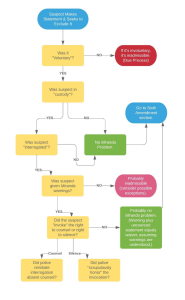Interrogations Flowchart Exercise
Interrogation Flowchart Exercise
Flowcharts can help students visualize what they have learned. The goal is not to memorize the example chart presented here but instead to create a new chart that helps one to connect material from throughout the book. Your authors recommend that when students make their own charts, they add additional detail, such as case names or chapter numbers. For example, in the box asking whether a statement was “voluntary,” such as Brown v. Mississippi, which is a particularly helpful case because its facts are so close to the line separating a voluntary confession from an inadmissible, involuntary confession.
This chart focuses on the Miranda Rule. A separate chart might depict Sixth Amendment law set forth in Massiah and related cases.

These charts have two primary purposes. One is that when the charts are finished, they can serve as study aids. The other is that the creation of the charts—even if students never review them after finishing them—forces students to consider material more carefully than they otherwise might, which helps with learning and with retention of information. Also, fellow students can help spot misunderstandings that, were they not in a chart, would remain uncorrected. Study group members might wish to bring charts to share with classmates.

